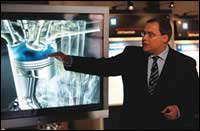GM has unveiled a highly innovative and practical solution to rising fuel prices, a new concept engine using technology called HCCI, which could offer the fuel-economy of a diesel while easily meeting current emissions standards.
So how does it work? Rather than using popular hybrid or fuel-cell technologies, HCCI stands for Homogenous Charge Compression Ignition, and the engine is unique because it can achieve combustion without a spark. Igniting a mixture of fuel and air by compressing it in the cylinder, HCCI produces a flameless, low-temperature release of energy throughout the combustion chamber. All the fuel in the chamber burns simultaneously, which produces power similar to normal engines, but uses less fuel. GM estimates that HCCI, combined with other technologies, can achieve 15 percent fuel savings over normal engines while using conventional gas or E85.
GM's HCCI engine can operate at speeds up to 55 mph -- above that or during heavy engine loads the system switches to conventional spark ignition. Because heat is required for HCCI to function, spark ignition is also used at startup, but GM has developed a breakthrough allowing the engine to operate in the fuel-saving mode at idle. This has been a challenge because the low temperatures and light engine loads when idling typically make controllable autoignition impossible. GM believes their achievement may be a first in the industry.
With HCCI mode able to run at idle, this opens up the technology to real-world driving situations, and GM recently demonstrated their invention in a Saturn Aura concept in New York and Washington, D.C. Running a 2.2-liter Ecotec 4-cylinder making 180 horsepower, the Aura offers diesel-like fuel economy without the need for any complex exhaust treatment. The system switches seamlessly from HCCI to spark ignition above 55 mph or when bursts of power are needed, such as when passing or pulling onto a freeway. Though an all-HCCI engine could potentially save even more fuel, program manager Dr. Matthias Alt explains that such a powerplant would be "heavier, noisier, more costly, and would not deliver the performance experience people expect from a modern car."
So when can we expect such an engine to reach production? There are still challenges to work out -- controlling combustion is more complex in an HCCI engine, and GM is still trying to get consistent performance in extreme hot and cold temperatures and at high altitudes. The HCCI development team has made great strides in reducing NVH, and more will be done to bring these down to acceptable levels. Additional testing is needed to make sure HCCI is ready, but running it in the Saturn Aura concept is a big first step.
GM's new engine shows that while high-profile projects like the Volt are important, simpler solutions like HCCI may prove just as vital to meeting future CAFE standards and reducing fuel consumption across automakers' lineups.

